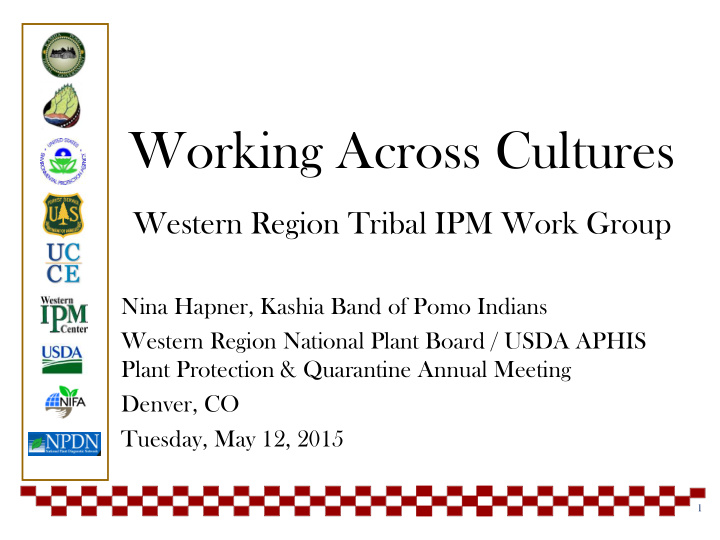



Working Across Cultures Western Region Tribal IPM Work Group Nina Hapner, Kashia Band of Pomo Indians Western Region National Plant Board / USDA APHIS Plant Protection & Quarantine Annual Meeting Denver, CO Tuesday, May 12, 2015 1
Western Region Tribal IPM Work Group Multi-tribal/multi-agency workgroup Goals Increase communication. Work cooperatively. Find management solutions that minimize negative impacts. Preserve native natural resources. 2
Mission Protect Tribal natural and cultural resources through understanding 3
Activities Five meetings Big Valley Rancheria, September 12, 2013 SCIHP, November 15, 2013 Yurok Tribe, February 25, 2014 Nevada, October 29, 2014 Pala Band of Mission Indians, August 19, 2014 TEK Work Shop, November 19, 2014 Participants Tribal communities Research organizations and government entities 4
Outcomes Current invasive pests information Expanded understanding Review of IPM management strategies Broader tribal participation in IPM invasive species management in the western U.S. Future potential projects and funding that will benefit all parties 5
Results of Needs Assessment Survey IRB-approved survey (http://ucanr.edu/survey/survey.cfm?surve ynumber=12917) Participation across meetings at various California locations, as well as via an online version of the survey 64 responses, almost evenly split between tribal (30) and non-tribal (32) participants 6
Top op inva vasiv ive s specie ies of of con oncern, c currently ly a and f for or t the future, among the e enti tire re W Work rk Group oup goldspotted oak borer (Agrilus auroguttatus) sudden oak death (Phytophthora ramorum) polyphagous shot hole borer (Euwallaecea species vectoring Fusiarum euwallacea) broom and gorse (Cytisus, Genista, and Ulexspecies) star thistle (Centaurea species) mistletoe (Phoradendron species) tamarisk (Tamarix species) beetles giant reed (Arundo donax) laurel wilt (Raffaelea lauricola) 7
Tribal concerns for current pests distinctly different from non-tribal respondents. While overlap on more than half of the responses, over 40% of the responses from one group were not included by the other. Tribal responses included 4 unique pests (mistletoe, Himalayan blackberry, acorn weevil, and vinca). Four pests mentioned by non-tribal participants were not included in any tribal responses. Even among the species that were agreed upon, the amount of importance each group gave an individual pest differed greatly. 8
Most Important Invasive Species Currently Impacting Natural Resources 9
Apparent differences in knowledge and practice of IPM techniques. Knowle wledge and d pr pract ctice ce of of IPM techn chniq ique ues, by group oup Are you familiar with Are you actively Do you practice IPM managing any of n IPM techniques? techniques? these pests? Total 76% 65% 69% 64 Tribal 57% 38% 48% 30 Non- 94% 96% 90% 32 Tribal 10
Consider: Is the definition of IPM clear? Fire – Eradication or control tool? IPM? 11
Things to Consider Plant Health Tool IPM = TEK What do you think TEK is? What do you consider a healthy system? With people? Without people? Do you know any Tribal Practitioners? People still collect traditional foods and medicines Still a significant part of diet and culture 12
Limitations to m man anage agement act action Tribal Non Tribal Money/funding 20 22 Knowledge 12 3 Environmental concerns 3 -- Approval of community/ 3 -- neighbors Regulations -- 4 Public opinion -- 2 13
Connections 14
What’s Next? Localized workshops in communities Received funding from Western IPM Center - Sharpening Tribal Skills in Forest Pest Detection and Response. Focus: SOD, PSHB, GSOB and field guide More tribal IPM projects Weave our Traditional Ecological Knowledge through mainstream IPM management policies 15
Work Group Base Kashia Band of Pomo Indians USDA-Forest Service, Pacific Southwest Research Station University of California Agriculture and Natural Resources, Cooperative Extension, Marin County Western Integrated Pest Management Center/Western Plant Diagnostic Network US EPA Region 9 Pesticide Programs 16
Partners needed to expand the current Work Group 17
Funding Western Integrated Pest Management Center http://www.wrpmc.ucdavis.edu/ Work Group Meetings Resources & Documents http://www.westernipm.org/index.cfm/center- projects/project-websites/tribal-work-group/ USDA Farm Bill, FY14-15 18
Nina Hapner, Director of Environmental Planning Kashia Band of Pomo Indians/Stewarts Point Rancheria nina@stewartspoint.org – (707) 591.0580 x 107 Susan Frankel, Plant Pathologist Invasives & Threats Team, Ecosystem Function & Health Program USDA-Forest Service, Pacific Southwest Research Station sfrankel@fs.fed.us – (510) 559-6472 Janice Alexander, Forest Health Educator UC Agriculture & Natural Resources, Cooperative Extension jalexander@ucanr.edu – (415) 473-3041 Carla Thomas, Associate Director National Plant Diagnostic Network, Western Region cthomas@ucdavis.edu - (707) 272-1994 Marcy Katzin US EPA Region 9 Pesticide Programs katzin.marcy@epa.gov – (415) 947-4215 19
Yawhee (Thank you) Bahnatí (ask me) 20
Recommend
More recommend